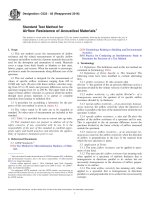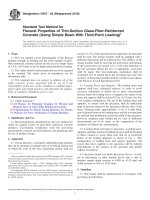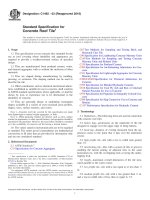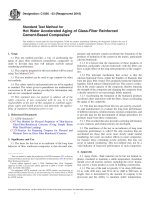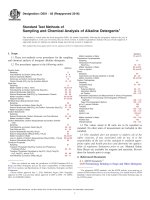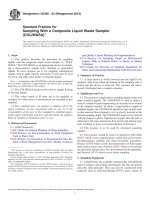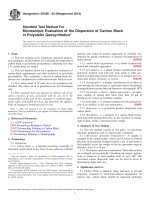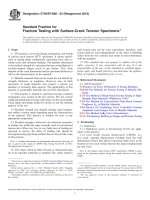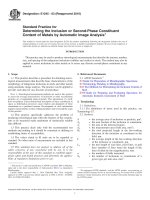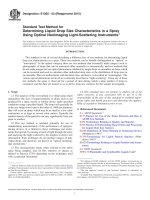Astm e 1245 03 (2016)
Bạn đang xem bản rút gọn của tài liệu. Xem và tải ngay bản đầy đủ của tài liệu tại đây (126.78 KB, 8 trang )
Designation: E1245 − 03 (Reapproved 2016)
Standard Practice for
Determining the Inclusion or Second-Phase Constituent
Content of Metals by Automatic Image Analysis1
This standard is issued under the fixed designation E1245; the number immediately following the designation indicates the year of
original adoption or, in the case of revision, the year of last revision. A number in parentheses indicates the year of last reapproval. A
superscript epsilon (´) indicates an editorial change since the last revision or reapproval.
INTRODUCTION
This practice may be used to produce stereological measurements that describe the amount, number,
size, and spacing of the indigenous inclusions (sulfides and oxides) in steels. The method may also be
applied to assess inclusions in other metals or to assess any discrete second-phase constituent in any
material.
2. Referenced Documents
1. Scope
2.1 ASTM Standards:2
E3 Guide for Preparation of Metallographic Specimens
E7 Terminology Relating to Metallography
E45 Test Methods for Determining the Inclusion Content of
Steel
E768 Guide for Preparing and Evaluating Specimens for
Automatic Inclusion Assessment of Steel
1.1 This practice describes a procedure for obtaining stereological measurements that describe basic characteristics of the
morphology of indigenous inclusions in steels and other metals
using automatic image analysis. The practice can be applied to
provide such data for any discrete second phase.
NOTE 1—Stereological measurement methods are used in this practice
to assess the average characteristics of inclusions or other second-phase
particles on a longitudinal plane-of-polish. This information, by itself,
does not produce a three-dimensional description of these constituents in
space as deformation processes cause rotation and alignment of these
constituents in a preferred manner. Development of such information
requires measurements on three orthogonal planes and is beyond the scope
of this practice.
3. Terminology
3.1 Definitions:
3.1.1 For definitions of terms used in this practice, see
Terminology E7.
3.2 Symbols:
1.2 This practice specifically addresses the problem of
producing stereological data when the features of the constituents to be measured make attainment of statistically reliable
data difficult.
1.3 This practice deals only with the recommended test
methods and nothing in it should be construed as defining or
establishing limits of acceptability.
1.4 The values stated in SI units are to be regarded as
standard. No other units of measurement are included in this
standard.
1.5 This standard does not purport to address all of the
safety concerns, if any, associated with its use. It is the
responsibility of the user of this standard to establish appropriate safety and health practices and determine the applicability of regulatory limitations prior to use.
1
This practice is under the jurisdiction of ASTM Committee E04 on Metallography and is the direct responsibility of Subcommittee E04.14 on Quantitative
Metallography.
Current edition approved May 1, 2016. Published May 2016. Originally
approved in 1988. Last previous edition approved in 2008 as E1245 – 03(2008).
DOI: 10.1520/E1245-03R16.
A¯
AA
Ai
AT
HT
=
=
=
=
=
L¯
=
LT
=
n
NA
=
=
the average area of inclusions or particles, µm2.
the area fraction of the inclusion or constituent.
the area of the detected feature.
the measurement area (field area, mm2).
the total projected length in the hot-working
direction of the inclusion or constituent in the
field, µm.
the average length in the hot-working direction
of the inclusion or constituent, µm.
the true length of scan lines, pixel lines, or grid
lines (number of lines times the length of the
lines divided by the magnification), mm.
the number of fields measured.
the number of inclusions or constituents of a
given type per unit area, mm2.
2
For referenced ASTM standards, visit the ASTM website, www.astm.org, or
contact ASTM Customer Service at For Annual Book of ASTM
Standards volume information, refer to the standard’s Document Summary page on
the ASTM website.
Copyright © ASTM International, 100 Barr Harbor Drive, PO Box C700, West Conshohocken, PA 19428-2959. United States
1
E1245 − 03 (2016)
Ni
NL
PPi
PPT
s
t
VV
X¯
Xi
λ
∑X
2
∑X
95 % CI
% RA
identification and individual measurement. Direct size measurement rather than application of stereological methods is
employed.
= the number of inclusions or constituent particles
or the number of feature interceptions, in the
field.
= the number of interceptions of inclusions or
constituent particles per unit length (mm) of scan
lines, pixel lines, or grid lines.
= the number of detected picture points.
= the total number of picture points in the field
area.
= the standard deviation.
= a multiplier related to the number of fields
examined and used in conjunction with the
standard deviation of the measurements to determine the 95 % CI
= the volume fraction.
= the mean of a measurement.
= an individual measurement.
= the mean free path (µm) of the inclusion or
constituent type perpendicular to the hotworking direction.
= the sum of all of a particular measurement over
n fields.
= the sum of all of the squares of a particular
measurement over n fields.
= the 95 % confidence interval.
= the relative accuracy, %.
5.3 Because the characteristics of the indigenous inclusion
population vary within a given lot of material due to the
influence of compositional fluctuations, solidification conditions and processing, the lot must be sampled statistically to
assess its inclusion content. The largest lot sampled is the heat
lot but smaller lots, for example, the product of an ingot, within
the heat may be sampled as a separate lot. The sampling of a
given lot must be adequate for the lot size and characteristics.
5.4 The practice is suitable for assessment of the indigenous
inclusions in any steel (or other metal) product regardless of its
size or shape as long as enough different fields can be measured
to obtain reasonable statistical confidence in the data. Because
the specifics of the manufacture of the product do influence the
morphological characteristics of the inclusions, the report
should state the relevant manufacturing details, that is, data
regarding the deformation history of the product.
5.5 To compare the inclusion measurement results from
different lots of the same or similar types of steels, or other
metals, a standard sampling scheme should be adopted such as
described in Practice E45.
5.6 The test measurement procedures are based on the
statistically exact mathematical relationships of stereology4 for
planar surfaces through a three-dimensional object examined
using reflected light (see Note 1).
4. Summary of Practice
4.1 The indigenous inclusions or second-phase constituents
in steels and other metals are viewed with a light microscope
or a scanning electron microscope using a suitably prepared
metallographic specimen. The image is detected using a
television-type scanner tube (solid-state or tube camera) and
displayed on a high resolution video monitor. Inclusions are
detected and discriminated based on their gray-level intensity
differences compared to each other and the unetched matrix.
Measurements are made based on the nature of the discriminated picture point elements in the image.3 These measurements are made on each field of view selected. Statistical
evaluation of the measurement data is based on the field-tofield or feature-to-feature variability of the measurements.
5.7 The orientation of the sectioning plane relative to the
hot-working axis of the product will influence test results. In
general, a longitudinally oriented test specimen surface is
employed in order to assess the degree of elongation of the
malleable (that is, deformable) inclusions.
5.8 Oxide inclusion measurements for cast metals, or for
wrought sections that are not fully consolidated, may be biased
by partial or complete detection of fine porosity or microshrinkage cavities and are not recommended. Sulfides can be
discriminated from such voids in most instances and such
measurements may be performed.
5.9 Results of such measurements may be used to qualify
material for shipment according to agreed upon guidelines
between purchaser and manufacturer, for comparison of different manufacturing processes or process variations, or to provide data for structure-property-behavior studies.
5. Significance and Use
5.1 This practice is used to assess the indigenous inclusions
or second-phase constituents of metals using basic stereological procedures performed by automatic image analyzers.
6. Interferences
5.2 This practice is not suitable for assessing the exogenous
inclusions in steels and other metals. Because of the sporadic,
unpredictable nature of the distribution of exogenous
inclusions, other methods involving complete inspection, for
example, ultrasonics, must be used to locate their presence.
The exact nature of the exogenous material can then be
determined by sectioning into the suspect region followed by
serial, step-wise grinding to expose the exogenous matter for
6.1 Voids in the metal due to solidification, limited hot
ductility, or improper hot working practices may be detected as
oxides because their gray level range is similar to that of
oxides.
6.2 Exogenous inclusions, if present on the plane-of-polish,
will be detected as oxides and will bias the measurements of
the indigenous oxides. Procedures for handling this situation
are given in 12.5.9.
3
Vander Voort, G. F., “Image Analysis,” Vol 10, 9th ed., Metals Handbook:
Materials Characterization, ASM, Metals Park, OH, 1986, pp. 309–322.
4
Underwood, E. E., Quantitative Stereology, Addison-Wesley Publishing Co.,
Reading, MA, 1970.
2
E1245 − 03 (2016)
are the same as described in Practice E45 (Microscopical
Methods) or as defined by agreements between manufacturers
and users.
6.3 Improper polishing techniques that leave excessively
large scratches on the surface, or create voids in or around
inclusions, or remove part or all of the inclusions, or dissolve
water-soluble inclusions, or create excessive relief will bias the
measurement results.
8.2 Characterization of the inclusions in a given heat lot, or
a subunit of the heat lot, improves as the number of specimens
tested increases. Testing of billet samples from the extreme top
and bottom of the ingots (after discards are taken) will define
worst conditions of oxides and sulfides. Specimens taken from
interior billet locations will be more representative of the bulk
of the material. Additionally, the inclusion content will vary
with the ingot pouring sequence and sampling should test at
least the first, middle and last ingot teemed. The same trends
are observed in continuously cast steels. Sampling schemes
must be guided by sound engineering judgment, the specific
processing parameters, and producer-purchaser agreements.
6.4 Dust, pieces of tissue paper, oil or water stains, or other
foreign debris on the surface to be examined will bias the
measurement results.
6.5 If the programming of the movement of the automatic
stage is improper so that the specimen moves out from under
the objective causing detection of the mount or air (unmounted
specimen), measurements will be biased.
6.6 Vibrations must be eliminated if they cause motion in
the image.
6.7 Dust in the microscope or camera system may produce
spurious indications that may be detected as inclusions.
Consequently, the imaging system must be kept clean.
9. Test Specimens
9.1 In general, test specimen orientation within the test lot is
the same as described in Practice E45 (Microscopical Methods). The plane-of-polish should be parallel to the hot-working
axis and, most commonly, taken at the quarter-thickness
location. Other test locations may also be sampled, for
example, subsurface and center locations, as desired or required.
7. Apparatus
7.1 A reflected light microscope equipped with bright-field
objectives of suitable magnifications is used to image the
microstructure. The use of upright-type microscope allows for
easier stage control when selecting field areas; however, the
specimens will require leveling which can create artifacts, such
as scratches, dust remnants and staining, on the polished
surface (see 12.2.1). The use of inverted microscopes usually
result in a more consistent focus between fields, thereby,
requiring less focussing between fields and a more rapid
completion of the procedure. A scanning electron microscope
also may be used to image the structure.
9.2 The surface to be polished should be large enough in
area to permit measurement of at least 100 fields at the
necessary magnification. Larger surface areas are beneficial
whenever the product form permits. A minimum polished
surface area of 160 mm2 is preferred.
9.3 Thin product forms can be sampled by placing a number
of longitudinally oriented pieces in the mount so that the
sampling area is sufficient.
7.2 A programmable automatic stage to control movement
in the x and y directions without operator attention is recommended (but not mandatory) to prevent bias in field selection
and to minimize operator fatigue.
9.4 Practice E768 lists two accepted methods for preparing
steel samples for the examination of inclusion content using
image analysis. The standard also lists a procedure to test the
quality of the preparation using differential interference contrast (DIC).
7.3 An automatic focus device may also be employed if
found to be reliable. Such devices may be unreliable when
testing steels or metals with very low inclusion contents.
10. Specimen Preparation
10.1 Metallographic specimen preparation must be carefully
controlled to produce acceptable quality surfaces for image
analysis. Guidelines and recommended practices are given in
Methods E3, and Practices E45 and E768.
7.4 An automatic image analyzer with a camera of adequate
sensitivity is employed to detect the inclusions, perform
discrimination, and make measurements.
7.5 A computer is used to store and analyze the measurement data.
10.2 The polishing procedure must not alter the true appearance of the inclusions on the plane-of-polish by producing
excessive relief, pitting, cracking or pullout. Minor fine
scratches, such as from a 1-µm diamond abrasive, do not
usually interfere with inclusion detection but heavier scratches
are to be avoided. Proper cleaning of the specimen is necessary.
Use of automatic grinding and polishing devices is recommended.
7.6 A printer is used to output the data and relevant
identification/background information in a convenient format.
7.7 This equipment must be housed in a location relatively
free of airborne dust. High humidity must be avoided as
staining may occur; very low humidity must also be avoided as
static electricity may damage electronic components.
Vibrations, if excessive, must be isolated.
10.3 Establishment of polishing practices should be guided
by Practice E768.
8. Sampling
10.4 Inclusion retention is generally easier to accomplish if
specimens are hardened. If inclusion retention is inadequate
with annealed, normalized, or low hardness as-rolled
8.1 In general, sampling procedures for heat lots or for
product lots representing material from a portion of a heat lot
3
E1245 − 03 (2016)
area. Some upright-type microscopes can be equipped with an
autoleveling stage for mounted specimens.
12.1.2 For an image analyzer that uses the TV-raster lines to
make intercept counts, align the specimen on the stage so that
the longitudinal direction is parallel to the y direction of the
stage and the inclusions are oriented vertically on the monitor
screen. For a software-based system, the longitudinal direction
of the specimen may be oriented parallel to either the x or y
axis of the stage.
12.1.3 The microscope light source should be checked for
correct alignment and the illumination intensity should be
adjusted to the level required by the television scanner tube.
12.1.4 Adjust the magnification of the system to provide
adequate resolution of the inclusions with the largest possible
field size. Choice of the optimum magnification is a compromise between resolution and field-to-field measurement variability. Higher magnification objectives have higher numerical
aperture ratings and provide improved resolution. However, as
magnification increases, the field-to-field measurement variability increases, which increases the standard deviation of the
measurement. Also, as the magnification increases, the field
area decreases. For example, if the magnification is doubled,
four times as many fields must be measured to cover the same
test area. In general, the lower the inclusion content, the higher
the required magnification, and vice-versa. Intermediate magnification objectives (for example, 32×, 40×, 50×, 60×, and
80×) provide the best combination of resolution and field area.
Avoid use of lower magnification objectives that will not
permit detection of the smaller inclusions. Use the same
objective for all measurements of specimens within a lot. It is
recommended that the same objective be used for all measurements of specimens with the same level of inclusion content,
for example, 32× to 50× objectives for grades with large
amounts of inclusions, such as free-machining grades, and 50×
to 80× objectives for vacuum degassed, ladle-refined, or
double-melt grades.
12.1.5 Select the optimum magnification and adjust the light
source for best resolution. If necessary, enable the shading
correction adjustment for chosen objective.
specimens, they should be subjected to a standard heat treatment (hardening) cycle, appropriate for the grade. Because
inclusion retention and cracking at carbides may be a problem
for certain steels in the as-quenched condition, tempering is
recommended; generally, a low tempering temperature, for
example, 200–260°C , is adequate.
10.5 Mounting of specimens is not always required depending on their size and shape and the available equipment; or, if
hand polishing is utilized for bulk specimens of convenient size
and shape.
10.6 The polished surface area for mounted specimens
should be somewhat greater than the area required for measurement to avoid edge interferences. Unmounted specimens
generally should have a surface area much greater than
required for measurement to facilitate leveling using the
procedure described in 12.1.1.
10.7 Etching of specimens is not desired for inclusion
assessment.
11. Calibration and Standardization
11.1 Use a stage micrometer to determine the size of the
frame to calibrate the image analyzer and to determine the
overall magnification of the system for each objective.
11.2 Follow the manufacturer’s recommendations in adjusting the microscope light source and setting the correct level of
illumination for the television pick-up camera.
11.3 The flicker method of switching back and forth between the inclusion image and the detected image is recommended to establish the correct setting of the gray-level
threshold controls as described in 12.2.1. Inspection of the gray
level histogram of the microstructure can be used to define the
gray level range and threshold settings for the inclusion or
constituent types (see 12.2.1). These settings are verified by the
flicker method.
12. Procedure
12.1 Setting Up the Microscope:
12.1.1 Place the specimen on the microscope stage so that
the specimen surface is perpendicular to the optic axis. With an
inverted-type microscope, simply place the polished face down
on the stage plate and hold it in place with the stage clamps.
With an upright-type microscope, place the specimen on a slide
and level the surface using clay or plasticene between the
specimen and slide. If tissue paper is placed between the
specimen surface and the ram of the leveling press, small
pieces of tissue paper may adhere to the surface during
flattening and produce artifacts that affect measurements. In
some cases, adherent tissue paper can be blown off the
specimen surface. An alternative leveling procedure to avoid
this problem is to place an aluminum or stainless steel ring
form of appropriate diameter, that has been flattened slightly in
a vise to an oval shape, between the specimen and the ram. If
the specimen was mounted, the ring form will rest only on the
surface of the mount. If the specimen is unmounted but with a
surface area substantially greater than required for
measurement, the ring form can rest on the outer edges of the
specimen during leveling and thus not affect the measurement
12.2 Setting the Densitometer:
12.2.1 Gray-level threshold settings are selected to permit
independent detection of sulfides and oxides, or a specific
discrete second phase, using the “flicker method” of switching
back and forth between the inclusion image and the thresholded image. The threshold limits are set for the oxides and the
sulfides so that the inclusions are detected without enlargement
of the larger inclusions. In some instances, the threshold
settings may require a minor compromise between detection of
the smallest inclusions and overdetection of the largest inclusions. The chosen threshold settings should be tried on inclusions in a number of fields before beginning the analysis. The
threshold range for oxides is close to the black end of the
reflectance scale while the range for sulfides is somewhat
higher. An alternate approach to establish the threshold settings
is to develop a gray-level reflectance histogram of the inclusion
or constituent types present, as well as the matrix (usually in
the as-polished condition). The histogram is used to identify
the start (darkest gray) and end (lightest gray) of the gray level
4
E1245 − 03 (2016)
12.5.3 For each field, count the number of discrete oxides
and sulfides and divide each number by the field area (mm2) to
define the number per unit area in accordance with:
range for each inclusion or constituent type and the intersection
gray level for two inclusions or constituent types with overlapping gray level ranges. Verify these settings by use of the
flicker method for several randomly selected fields.
12.2.2 For steels with very low inclusion contents and very
small inclusions, it may not be possible to reliably separate
oxides from sulfides. In such cases, detect all inclusions
without attempting a separation. For other metals containing
inclusions of one or more types, adjust the threshold settings to
separate them by type or collectively as required by the
particular application.
NA 5
NL 5
Ni
LT
(3)
For software-based systems, where the pixel rows, an
artificially created grid, or some other approach is used to
produce intercept counts, the longitudinal direction must be
perpendicular to the intercept count direction. NL is determined
in the same manner except that LT must be based on the true
length of the pixel rows or the artificial grid lines. For either
type of measurement, store in the computer memory NL and NL
2
for each type of inclusion (sulfide and oxide) or constituent.
12.5.5 If field measurements are employed to determine the
inclusion or particle lengths (in the hot working direction), for
each field that contains inclusions or particles, measure the
total projected length, H T, (in µm) of each inclusion or
precipitate type. Store in the computer memory the total
projected length per field and the number of inclusions per
field, Ni, for each type of inclusion (sulfide and oxide) or
constituent.
12.5.6 If feature-specific measurements are used to determine the size of the inclusions or particles, measure the
inclusion length (in the hot working direction) and area for
each inclusion in the field. A protocol must be employed to
correct for edge effects for inclusions or particles lying on a
field boundary to ensure that these inclusions or particles are
properly measured only once. Store in the computer memory
the length, Li, and area, Ai, of each measured inclusion (sulfide
and oxide) or constituent type.
12.5.7 Move the stage to the next field, refocus, and repeat
the measurements described in 12.5.1 – 12.5.6. Add the second
set of field measurements (AA, AA 2, NA, N A 2, N L, NL 2, HT, Ni)
to the first set, and so forth, as the number of fields increases,
to obtain the sum of each measurement and each measurement
squared for each inclusion type (oxide and sulfide) or constituent type for n fields. Alternatively, if computer memory is not
a problem, store each field value of AA, NA and N L. For the
feature-specific measurements Li and Ai, store all of the
individual measurements.
12.5.8 For those cases where oxides and sulfides cannot be
separated, perform the measurements described in 12.5.1 –
12.5.6 on all of the inclusions. For other metals, perform the
measurements on the constituents present either separately or
collectively as required by the application.
12.4 Setting Up the Computer:
12.4.1 The computer program developed for data input,
image analyzer control, measurement, and data analysis is read
into the central processing unit to commence analysis. Input
data regarding the specimen identity, data requester, calibration
constant, date, number of fields, field spacing, and so forth, are
entered.
12.5 Measurement of Stereological Parameters:
12.5.1 All the stereological measurements can be performed
as field measurements. Two measurements, the inclusion or
constituent length and area, also can be performed as featurespecific measurements, if desired, although this may be slower.
12.5.2 For each field, focus the image (manually or automatically) and measure the area fraction of the detected oxides
and sulfides by dividing the detected area of each by the area
of the measurement field or by dividing the total number of
detected picture points by the total number of picture points in
each field. The volume fraction is equal to the area fraction as
defined by:
Ai
PPi
5
AT
PPT
(2)
A counting protocol must be chosen to correct for edge
effects so that an inclusion or constituent lying across a field
boundary is counted only once. Store in the computer memory
the number per unit area and the number per unit area squared
of the oxides and sulfides.
12.5.4 With an image analyzer that utilizes the raster lines
for intercept counting, for each field, count the number of
feature interceptions of the horizontal scan lines with the
vertically oriented oxides and sulfides and divide this number
by the total length of the horizontal scan lines per field as:
12.3 Stage Movement:
12.3.1 The stage controls are set to move the specimen in a
square or rectangular pattern without running off the specimen
surface. Depending on the area of the plane-of-polish and the
number of fields to be measured, the fields can be aligned
contiguously or spaced apart somewhat. Field areas should not
be overlapped. If the fields are aligned contiguously over a
square or rectangular area, after examination of the fields, the
detected features in these fields can be added together to
minimize edge correction problems.
12.3.2 For a given inclusion content, the statistical precision
of the measurements improves as the area measured increases.
The measured area depends on the size of each field, which
decreases with increasing magnification, and the number of
fields measured. The number of fields measured should be
based on the relative accuracy of the measurements as defined
in 13.4 or by agreement between producer and purchaser.
12.3.3 When the sections are stacked within a mount to
produce the desired measurement area, stage movement must
be carefully adjusted so that the interface between two adjacent
specimens is not included within the measurement field.
VV 5 AA 5
Ni
AT
(1)
The volume fraction may be expressed as a percentage, if
desired, by multiplying the area fraction or point fraction by
100. Store in the computer memory the volume fraction and the
volume fraction squared of the sulfides and oxides.
5
E1245 − 03 (2016)
12.5.9 If exogenous inclusions are observed on the planeof-polish of a test specimen, the approximate length and width
of the exogenous matter should be measured and reported
separately. The depth of the exogenous inclusion can be
determined, if desired, by sectioning through the inclusion
perpendicular to the original sectioning plane. Because exogenous inclusions are not randomly distributed, stereological
measurement methods are not appropriate. A new specimen for
stereological measurement of the indigenous inclusions should
be prepared from an adjacent section, or after a cut-back,
depending on the nature of the application, or as defined by
other specifications, or as defined by purchaser-producer agreements.
12.5.10 Ratio parameters, such as the average inclusion area
or the mean free path, based on field measurements should be
calculated (as described in 13.7, 13.8 and 13.10) only from the
mean values of A¯ A, N¯A and N¯ L after all the n fields have been
assessed. Do not determine L¯, A¯ and λ for each field.
deviation does not accurately define the data dispersion for these
measurements, it may still be used for comparative purposes as described.
NOTE 3—The standard deviation of the mean free path can only be
calculated if the constituent of interest is present in every field (See Note
2 and Note 4).
13.3 Next, calculate the 95 % confidence interval, 95 % CI,
for each measurement for both oxides and sulfides by:
95 % CI 5 ts/ =n
The value of each measurement is expressed as the mean
value plus or minus the 95 % CI. Table 1 lists the values of t as
a function of n. Over n = 30, the value of t may be defaulted to
a value of 2.
13.4 Next, calculate the percent relative accuracy, % RA, of
each measurement for oxides and sulfides by:
% RA 5
13.1 After the desired number of fields, n, have been
measured, calculate the mean value of each field measurement
(AA, NA, NL) stored in memory by dividing the sum of each
measurement for n fields by n to determine the average area
fraction A¯ A (as a fraction or as a percentage, as desired), the
average number per unit area N¯ A (per mm2), and the average
number of interceptions per unit length N¯ L (per mm).
Alternatively, if the individual field values of AA, NA and NL
have been stored, compute the mean of each in the usual way
(the sum of the measurements divided by n) for each inclusion
(oxide and sulfide) or constituent type. The average area A¯ (in
µm2) and the average length L¯ (in µm) for oxides and sulfides
are calculated by dividing by the number of fields with
detectable oxides and sulfides rather than the total number of
fields (unless all fields measured have detectable oxides and
sulfides).
X2
2
n
X
n
2
1/2
(4)
13.6 If the inclusions cannot be separated by type and are
analyzed collectively, or if other constituents are analyzed
separately or collectively for metals other than steels, apply the
analytical treatment as described in 13.1 – 13.5 as appropriate.
If the individual field measurements of AA, N A, and NL have
been stored in memory, calculate the standard deviation according to:
F (~
G
2
1/2
X i 2 X¯ !
(5)
n21
NOTE 2—The dispersion of inclusion field measurement data does not
conform to the ideal Gaussian (normal) form and the deviation from
normalcy increases as the inclusion content decreases. Thus, the arithmetic standard deviation, calculated by (Eq 4 or Eq 5), does not accurately
describe the dispersion of the test values about the arithmetic mean of
these measurements. The true data dispersion can be defined by the
four-moment method5 and calculation of the geometric mean, geometric
standard deviation, skew, and kurtosis. However, such calculations are
beyond the scope of this practice. Although the arithmetic standard
s5
(7)
13.5 If the percent relative accuracy is too high, more fields
can be measured. As the area fraction decreases, it will be
difficult to obtain percent of RA values below 30 %. For very
low area (volume) fractions, percent RA values less than 100 %
may be difficult to obtain within a practical measurement time.
For most work, the number of fields measured should be in the
range of from 200 to 300. A greater number of fields, that is,
greater measurement area, may be employed depending on the
requirements of the study. However, as the area measured
increases, the improvement in the percent of relative accuracy
decreases and, beyond some number of fields (area measured),
the improvement in the percent relative accuracy will be small
compared to the required effort. For steels with very low
inclusion contents where the percent of relative accuracies of
the measurements are relatively high, measurement of 200 to
300 fields per specimen on a larger number of specimens is
recommended rather than measuring 500 or more fields on a
smaller number of specimens. This procedure produces better
statistical definition of the inclusions in the lot.
13.2 If the sum of AA, A A 2, N A, NA 2, NL, and NL 2 have been
stored in memory, calculate the standard deviation of the field
measures by:
F( F( G G
95 % CI
3 100
X¯
The relative accuracy is an estimate of the percent of error of
each measurement as influenced by the field-to-field variability
of the values.
13. Calculation of Results
s5
(6)
TABLE 1 95 % Confidence Interval Multipliers
No. of Fields, n
5
6
7
8
9
10
11
12
13
14
15
16
17
5
Vander Voort, G. F., “Inclusion Measurement,” Metallography As A Quality
Control Tool, Phenum Press, NY, 1980, pp. 1–88.
6
t
2.776
2.571
2.447
2.365
2.306
2.262
2.228
2.201
2.179
2.160
2.145
2.131
2.120
No. of Fields, n
18
19
20
21
22
23
24
25
26
27
28
29
30
t
2.110
2.101
2.093
2.086
2.080
2.074
2.069
2.064
2.060
2.056
2.052
2.048
2.045
E1245 − 03 (2016)
14.5 For all of the specimens in the lot, list the mean values
for inclusion (oxide and sulfide) or constituent type per
specimen and compute average values of each measurement to
produce lot averages.
13.7 If field measurements of the total projected length of
each inclusion or particle type have been made, calculate the
average length of each inclusion or particle type, L¯, according
to:
L¯ 5
(H
(N
T
14.6 For all of the specimens in the lot, compute the
standard deviation (in accordance with (Eq 4 or Eq 5)), the
95 % CI (in accordance with (Eq 6)) and the percent RA (in
accordance with (Eq 7)) for each measurement type to assess
the statistical value of the data. For these calculations, n is the
number of specimens in the lot rather than the number of fields
measured.
(8)
i
where HT and L¯ are in µm.
13.8 If feature-specific measurements of inclusion or constituent areas have not been made, use the average values of A¯A
and N¯A (determined in 13.1) to calculate the average area, A¯, of
each inclusion or particle type by:
A¯ A
A¯ 5
N¯
NOTE 4—The comments in Note 2 (after 13.2) do not apply in this
situation because the dispersion of the mean values for each specimen
about their mean (heat average) will be Gaussian (normal).
(9)
14.7 If the oxides and sulfides cannot be separated and are
measured collectively, list the values for all inclusions for each
sample and calculate lot averages. If other constituents are
analyzed separately or collectively in specimens other than
steels, list the measured averages per specimen under the
appropriate identifying headings and calculate lot averages.
Next, calculate the standard deviation, 95 % CI and percent RA
for the lot averages as described in 14.6.
A
where A¯A must be expressed as a fraction (not as a percentage). Since N¯A is the number per mm2, multiply A¯ by 106 to
obtain the mean area in µm2.
13.9 If feature-specific measurements of the inclusion or
particle length and area have been measured, Li and A i,
respectively, compute the mean, L¯ and A¯. The individual
measurement data may be used to develop frequency histograms of length or area, if desired. The standard deviation of
the length or area measurements may be calculated according
to Eq 5 (see Note 2). Then, calculate the 95 % confidence
interval and the % RA as described in 13.3 and 13.4 for the
individual length and area measurements.
14.8 For the oxides and sulfides, or the total inclusion
content if measured collectively, or for other constituents
measured, list the lot averages for each measurement type,
followed by the standard deviation, the 95 % confidence
interval, and the percent relative accuracy.
13.10 Calculate the mean free path, that is, the mean
edge-to-edge distance between inclusions (oxide and sulfide)
or particle types, perpendicular to the hot-working axis according to:
14.9 Report the location and size of any exogenous inclusions encountered and the action taken to prepare a replacement specimen for stereological measurement of the indigenous inclusions.
λ5
1 2 A¯ A
N¯
15. Precision and Bias
(10)
15.1 Improper sectioning of the specimen that inclines the
plane-of-polish off the longitudinal axis will produce bias in
the measurements, particularly the number per unit area, the
average area and the average length. Misorientations greater
than 5° from the longitudinal axis must be avoided.
L
where λ is the mean free path perpendicular to the hot
working axis in µm of each inclusion or constituent type, A¯A is
expressed as a fraction (not as a percentage) and N¯ L (the mean
number of intercepts per mm) must be multiplied by 1000.
15.2 Voids in the microstructure due to solidification, inadequate hot ductility, improper hot working practices, or improper polishing will be detected as oxides and bias the volume
fraction and number per unit area to higher values. The average
area, average length, and mean free path will be biased towards
lower values.
14. Test Report
14.1 The report should document the identifying information in 12.4.1 regarding the specimen, its origin, data requester,
date of analysis, and so forth as needed.
14.2 List the number of fields measured, the area per field
and the total measurement area.
15.3 The presence of dust or other debris on the polished
surface or dust in the imaging system will bias results towards
higher values.
14.3 For the measured quantities of each inclusion (sulfides
and oxides) or constituent particle type, list each measured
value, the standard deviation, the 95 % confidence interval, and
the percent relative accuracy. For the ratio parameters, list only
the calculated mean value. This information may be tabulated
in several ways depending on the needs of the application. If
individual measurements of length and area have been
obtained, these results may be plotted in histogram manner, if
desired.
15.4 Improper stage movement control that permits the
objective to measure the mount or free space will bias results.
15.5 Vibrations that affect the detected image will bias
results.
15.6 The choice of the magnification used will influence test
results. In general, specimens with large inclusions must be
examined at lower magnifications than specimens with a low
density of small inclusions. Inclusions that intersect the frame
14.4 This format is repeated for each specimen in the lot.
7
E1245 − 03 (2016)
prohibitive amount of measurement time. A point will be
reached where the addition of more fields yields very little
improvement in the percent relative accuracy. At this point, it
is impractical to continue the analysis. Field areas should be
spaced apart or aligned contiguously, never overlapped.
border will be partially detected and a relatively low magnification reduces this problem. For specimens with very small
inclusions, higher magnifications must be employed for adequate detection and measurement. However, as the magnification increases, the field area decreases and the field-to-field
variability, which influences the standard deviation, increases.
As the magnification is decreased, the NA value will decrease
and the L¯, A¯ and λ¯ values increase because the smaller
inclusions will not be detected. Consequently, results should
not be compared if significantly different objective magnifications were used for measurements. The same objective should
be used for all measurements of specimens in the same lot.
Low magnification objectives should be avoided. Intermediate
magnification objectives, e.g., 32× 40×, 50×, 60× and 80×,
provide the best combination of resolution and field size. As
the AA value decreases, the average inclusion size usually
decreases, and higher magnification objectives are required.
15.9 If the specimen is repolished so that a new parallel
plane is measured, reproducibility will not be as good as when
the same plane is remeasured.
15.10 Characterization of the inclusion content within a
given heat lot, or a subunit of the heat lot, improves as the
number of specimens measured increases. For the testing of
billets rolled from ingots, the practice of sampling only the
extreme tops and bottoms may not be representative of the bulk
material. These locations may present extremes in the oxide
and sulfide contents. The addition of billet locations within the
ingot is recommended to include conditions representative of
the bulk of the material. Likewise, for a heat of steel, the
inclusion content may vary substantially within the ingot
sequence. Hence, as the number of systematically selected test
locations increases, the ability to characterize the inclusion
content improves. The same rules apply to sampling of
continuously cast material.
15.7 Improper setting of the threshold ranges for detection
and discrimination of phases or inclusions will bias results. If
the detection scheme appears to be inadequate, the operator
should abort the run and reset the threshold levels.
15.8 The precision of the measurements is a direct function
of the measurement area, that is, the field size and the number
of fields measured. Hence, precision can be improved simply
by increasing the number of measurement fields until the
percent of relative accuracy reaches the desired level. As the
volume fraction of the inclusions decreases, a greater measurement area is required to obtain an acceptable precision. For
very low inclusion content specimens, this may require a
16. Keywords
16.1 exogenous inclusion; feature-specific measurements;
field measurements; image analysis; inclusions; indigenous
inclusions; light microscopy; oxide; second-phase particles;
statistical analysis; stereology; sulfide
ASTM International takes no position respecting the validity of any patent rights asserted in connection with any item mentioned
in this standard. Users of this standard are expressly advised that determination of the validity of any such patent rights, and the risk
of infringement of such rights, are entirely their own responsibility.
This standard is subject to revision at any time by the responsible technical committee and must be reviewed every five years and
if not revised, either reapproved or withdrawn. Your comments are invited either for revision of this standard or for additional standards
and should be addressed to ASTM International Headquarters. Your comments will receive careful consideration at a meeting of the
responsible technical committee, which you may attend. If you feel that your comments have not received a fair hearing you should
make your views known to the ASTM Committee on Standards, at the address shown below.
This standard is copyrighted by ASTM International, 100 Barr Harbor Drive, PO Box C700, West Conshohocken, PA 19428-2959,
United States. Individual reprints (single or multiple copies) of this standard may be obtained by contacting ASTM at the above
address or at 610-832-9585 (phone), 610-832-9555 (fax), or (e-mail); or through the ASTM website
(www.astm.org). Permission rights to photocopy the standard may also be secured from the Copyright Clearance Center, 222
Rosewood Drive, Danvers, MA 01923, Tel: (978) 646-2600; />
8
